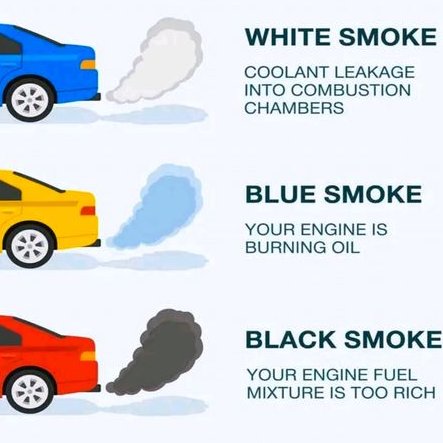Decoding the Colors of Car Exhaust Smoke

Uncover what your car is trying to tell you through the smoke it emits. Learn the meanings behind different exhaust smoke colors and what they indicate about your vehicle's health.
Understanding Exhaust Smoke: What Does It Tell Us?
Exhaust smoke can provide valuable insights into the health of your vehicle's engine. By understanding the different colors of smoke and what they indicate, you can diagnose potential issues before they become major problems.
When examining exhaust smoke, it's important to consider the color, consistency, and smell. These factors can help you determine whether the smoke is a normal byproduct or a sign of a more serious issue.
In general, exhaust smoke can be categorized into three main colors: white, blue, and black. Each color has its own set of meanings and potential causes.
White Smoke: Condensation or Cause for Concern?
White smoke is commonly seen when starting a cold engine, especially in colder weather conditions. This is usually caused by condensation in the exhaust system, which is a normal occurrence. As the engine warms up, the white smoke should dissipate.
However, if white smoke continues even after the engine has warmed up, it could be a sign of a more serious issue. Possible causes of persistent white smoke include a blown head gasket, a cracked cylinder head, or a damaged cylinder wall. If you notice white smoke that doesn't go away, it's important to have your vehicle inspected by a qualified mechanic.
In addition to the color, it's important to pay attention to the consistency and smell of the white smoke. Thick white smoke that has a sweet smell could indicate a coolant leak, while thin white smoke with a burning smell could be a sign of burning oil.
Blue Smoke: Oil Burn-off and Engine Health
Blue smoke is often a sign of oil burn-off, which can occur when oil leaks into the combustion chamber and gets burned along with the fuel. This can be caused by worn piston rings, worn valve seals, or a malfunctioning PCV (Positive Crankcase Ventilation) system.
While a small amount of blue smoke during startup or after prolonged idling is normal for some older vehicles, excessive or persistent blue smoke can indicate more serious issues. It could be a sign of worn engine components that require repair or replacement.
If you notice blue smoke coming from your exhaust, it's important to have your vehicle inspected by a qualified mechanic to determine the underlying cause and prevent further damage to the engine.
Black Smoke: Fuel Issues and Efficiency
Black smoke is usually a sign of fuel-related issues. It can occur when the air-fuel mixture in the engine is too rich, meaning there is too much fuel and not enough air. This can be caused by issues such as a clogged air filter, a malfunctioning fuel injector, or a problem with the fuel pressure regulator.
In addition to fuel issues, black smoke can also indicate poor fuel efficiency. When the engine is not burning fuel efficiently, it can result in wasted fuel and increased emissions. This can be detrimental to both the environment and your wallet.
If you notice black smoke coming from your exhaust, it's important to have your vehicle inspected and diagnosed by a qualified mechanic. They can identify the specific cause of the fuel-related issue and recommend the necessary repairs or adjustments to improve fuel efficiency.
Diagnosing and Addressing Common Exhaust Problems
In addition to the specific smoke colors mentioned above, there are other common exhaust problems that can affect the performance and health of your vehicle.
One such issue is excessive smoke of any color. If you notice an unusually large amount of smoke coming from your exhaust, it could be a sign of a serious problem that requires immediate attention. It's important to have your vehicle inspected by a qualified mechanic to identify and address the underlying issue.
Other common exhaust problems include loud or unusual noises, strong odors, and reduced performance. These issues can be caused by various factors such as a faulty catalytic converter, a damaged muffler, or a malfunctioning oxygen sensor. Again, it's important to consult with a qualified mechanic for a proper diagnosis and repair plan.
By paying attention to the colors of your car's exhaust smoke and understanding their meanings, you can gain valuable insights into the health of your vehicle's engine. Regular maintenance, prompt inspections, and timely repairs are key to keeping your car running smoothly and efficiently.

 Loading..
Loading..